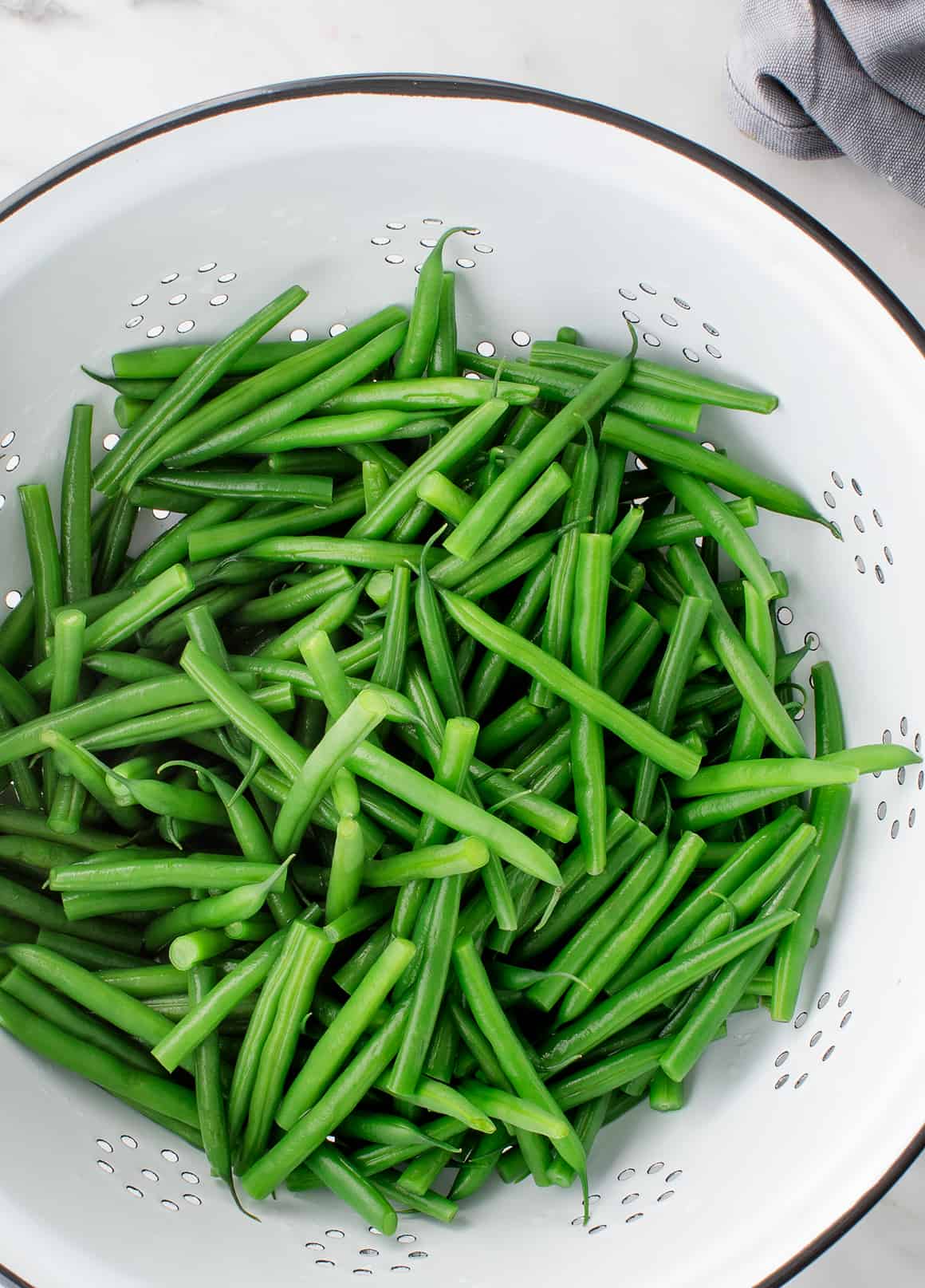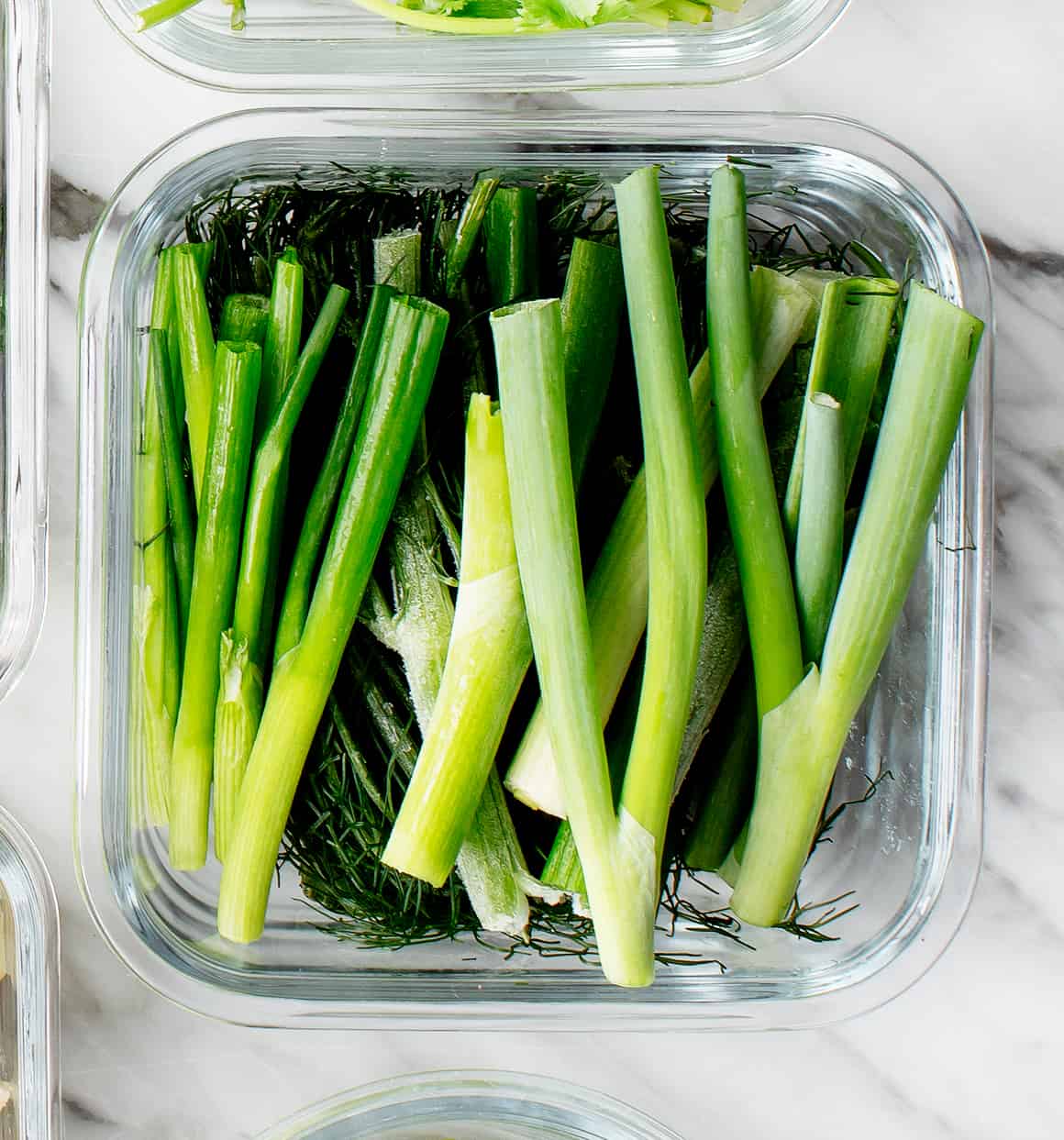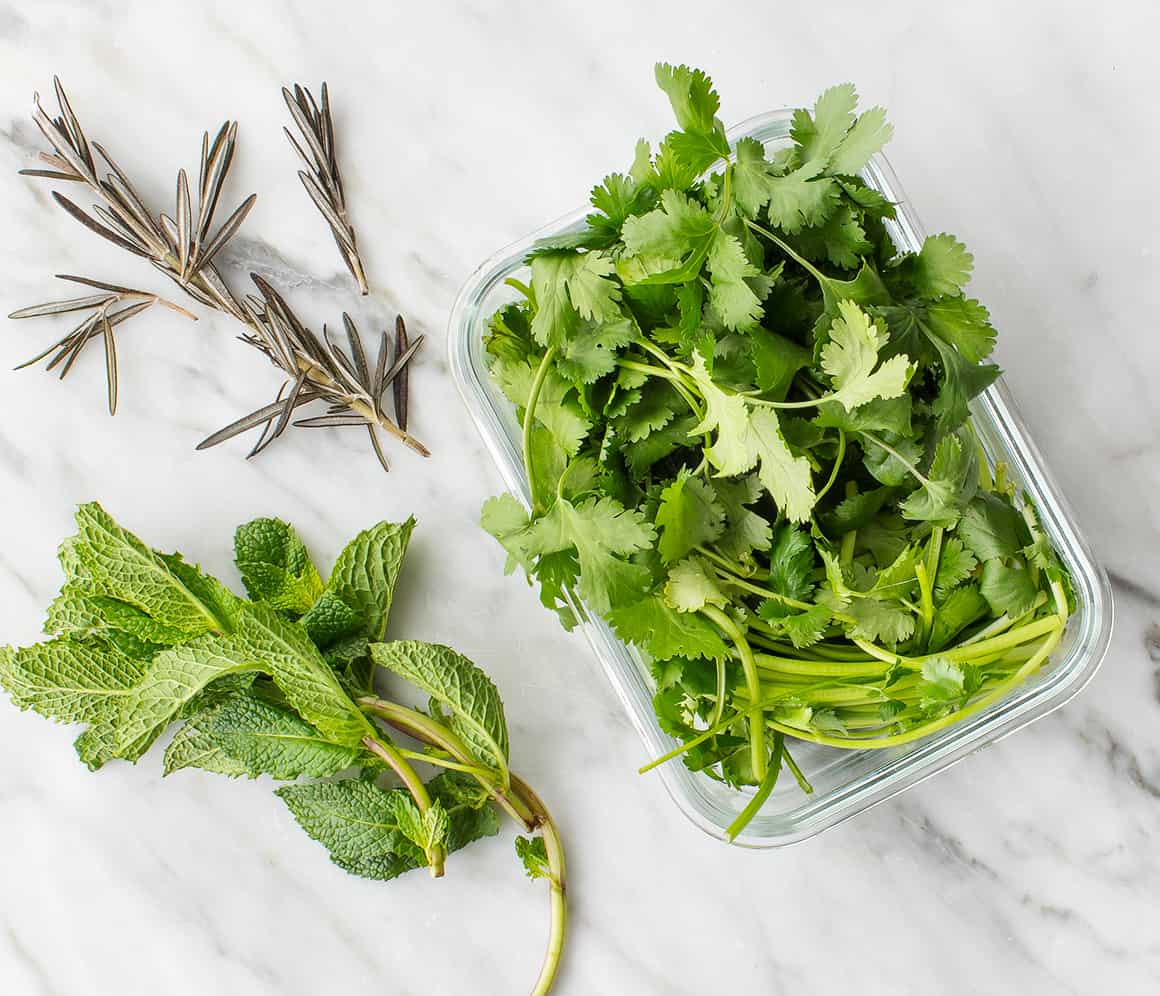Don't let those green beans or zucchini go to waste! Learn how to freeze vegetables, how to thaw them, and how to use them in a way you'll love.

Welcome to Part 2 of my guide to storing vegetables! On Friday, I wrote about my favorite vegetables that keep for at least a week at room temperature or in the fridge. Today’s post is all about freezing veggies!
I don’t know about you, but when I went to the store last weekend to stock up on groceries, frozen vegetables were nowhere to be found. How was I going to keep a supply of produce on hand for 2+ weeks? Luckily, the fresh produce section was still well-stocked. If I couldn’t buy frozen vegetables, I could freeze my own!
Freezing vegetables preserves their nutritional value, so they’re a great substitute for fresh if you can’t make a trip to the store or farmer’s market. They work well in recipes like soups, stir-fries, and smoothies – anytime you’d use steamed, blanched, sautéed, or blended veggies. I don’t recommend roasting frozen vegetables, as they won’t become brown and crisp in the same way that raw vegetables would. And of course, not every vegetable freezes well. Avoid freezing anything you’d want to eat raw in a salad, like cucumbers or radishes. However, other vegetables freeze well for months, and they’re fantastic in all kinds of dishes. Here’s what I stocked up on and how I froze it:

Green beans, Snap Peas, and Snow Peas
How to prep: Wash the veggies and blanch them for 2 minutes. Transfer them to a bowl of ice water to cool, drain them, and allow them to dry completely. Then, spread them in a single layer on a parchment-lined baking sheet and freeze for 2 hours, or until fully frozen. Finally, transfer them to airtight bags or containers to freeze for several months.
How to use them: Steam or blanch the frozen veggies to serve as a side dish, or toss them into stir-fries and soups. Try using frozen snap peas in the Lemon Miso Spring Green Soup on page 89 of Love and Lemons Every Day!
Broccoli and Cauliflower
How to prep: Wash the vegetables and cut or break them into florets. Blanch them for 3 minutes, transfer them to a bowl of ice water to cool, drain them, and allow them to dry completely. Then, spread them in a single layer on a parchment-lined baking sheet and freeze for 2 hours, or until fully frozen. Finally, transfer them to airtight bags or containers to freeze for several months.
How to use them: Steam or blanch frozen broccoli or cauliflower just until thawed. Then, serve it as a side dish, or add it to soups, curries, bowls, or frittatas. Puree thawed cauliflower into my homemade Alfredo sauce, or toss broccoli or cauliflower florets into any of these pasta recipes:
Zucchini
How to prep: Wash the zucchini thoroughly, allow it to dry completely, and cut it into 1-inch chunks. Then, transfer it to airtight bags or containers to freeze for several months.
How to use it: I like to blend frozen zucchini into smoothies! It adds extra nutrients and creates a super creamy texture.
Leafy Greens
How to prep: Wash leafy greens like spinach or kale and dry them thoroughly. Transfer them to airtight bags or freezer containers with a paper towel to soak up any excess moisture, and freeze for up to several months.
How to use them: Blend them into smoothies or add them to pastas or soups.
Ginger
How to prep: Wash ginger root and allow it to dry completely. Store it, unpeeled, in freezer bags or containers for several months.
How to use it: Peel frozen ginger and grate it to add to porridge, curries, soups, and sauces. Try using it in the Sunshine Sweet Potato Curry on page 193 of Love and Lemons Every Day!
Herbs
Which ones to look for: Hearty herbs like rosemary and thyme freeze best, but softer leafy herbs like mint, cilantro, or basil are also good additions to soups and sauces.
How to prep: Wash and dry herbs thoroughly. Place in freezer-safe bags or containers with a paper towel to soak up any remaining moisture as they freeze. Alternatively, blend fresh herbs into pesto and freeze it in ice cube trays.
How to use them: Chop frozen herbs with a knife or use your hands to crunch and crumble softer herbs. Then, add them to soups, sauces, and pasta recipes. Thaw pesto overnight in the fridge. Then, toss it with pasta for an easy meal.
Avocado
How to prep: Halve an avocado, remove it from the skin, and slice it. Freeze it in freezer bags or containers for up to a month.
How to use it: Add frozen avocado directly to smoothies, or let it thaw at room temperature for about 20 minutes. To avoid browning, use it as soon as it thaws. Avocado toast, anyone?
Fruits
Which ones to look for: Berries, bananas, mango, and pineapple. I also like to freeze lemon zest!
How to prep: Wash berries and allow them to dry completely, peel ripe bananas, and peel and dice mango and pineapple. Store them in freezer bags or containers in the freezer for up to two months.
How to use them: I keep frozen fruit on hand to blend into smoothies, but it’s also delicious with oatmeal, overnight oats, or baked oatmeal for breakfast. Use frozen blueberries instead of fresh in my blueberry muffins or scones (no need to thaw them first!), or thaw frozen bananas to make into banana bread, pancakes, or muffins.

Vegetable Scraps
Which ones to save: Scallion tops, fennel fronds, herb stems, extra onion pieces
How to use them: Make homemade vegetable broth! There’s a recipe for Scrap Stock on page 106 of Love & Lemons Every Day.
Now is a great time to sign up for a CSA box!
If you live in an area where there are bountiful farmers markets at this time of year, now is a great time to look into signing up for a CSA, or a Community Supported Agriculture program. CSAs allow you to pay up front for a box of produce from a local farm. Oftentimes, you can choose the size and frequency of your box, which is either delivered to your home or dropped off at a nearby location for pickup. It’s a great way to support local farmers, get top-notch produce, and skip a trip to the grocery store. Look for a CSA near you here!
Looking for more recipes for a week at home?
Check out my freezer meal guide, my best pantry recipes, these healthy meal prep tips, or these super fun baking recipes!
















would it be possible to freeze celery as well?
Hi Zack, I haven’t tried it, but if you wash it well and dry it, I think it would work! I recommend chopping it before freezing too. Use it in cooked dishes like soups and stews after thawing.
what about bell peppers? should you blanch those as well?
Hi Emily, I chop them and freeze them raw.
We quarter them, char the skin in the broiler, freeze them on a sheet pan, and then bag them so they don’t stick together. You can’t chop them but they are ‘free’ homegrown, roasted sweet peppers for cooking all winter.
What about potatoes
They keep well at room temp in a cool, dry place, which is why I didn’t include them here. But you can freeze roasted cubed sweet potato if you’d like.
Thank you for posting these tips. I have passed them on to friends.
When I was a kid, my family had 2 very productive peach trees. We would freeze A LOT of organic peaches every season. We never peeled them. We simply washed them, sliced them, and froze them in freezer bags.
We did the same thing with our homegrown tomatoes. My mom had 48 tomato plants in her organic garden every year, so we had excellent tomatoes all year round.
We also used to can both tomatoes and peaches or make the fruit into jam which we would give as holiday gifts.
Don’t forget to write the date of freezing on your freezer bags! We’ve all found bags of stuff we forgot about in the back of the freezer, LOL.
Thanks Jeanine for all you share with us.
I put scallions, with roots intact, in a clear glass jar or drinking glass, with just a 1/2″ or so of water. THEY KEEP GROWING! They’re in the window above my sink. I just harvest as I need. They are so beautiful and happy.
YES, you need to change the water, rinse the glass every couple of days. And, I love this solution.
I just started doing that too! So fun 🙂 xoxo
I froze a lot of tomatoes last season, and they still taste great. All I did was collect all the ripe ones each day, and whatever we didn’t eat, I stuck them into a plastic bag and put them in the freezer. To use, get a pot or a bowl of hot water, drop in your tomatoes, wait a minute or so, peel the skin off, cut the stem out, chop them up to whatever size you want, and finally throw into a pot to use for soup or sauce.
Thanks for the tips!
This is so helpful. Thank you
you’re welcome!
Would it work to roast pre-frozen zucchini, or better to roast first and then freeze?
Hi Kristie,
I wouldn’t suggest either – it gets very watery once it’s frozen and thawed which is why I like frozen zucchini best in smoothies. In a pinch, it can be added to soups, but I’ve found it to be mushier than I like so I usually opt for other veggies.